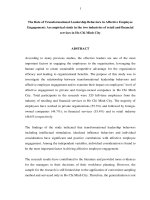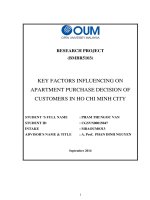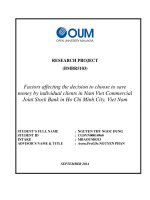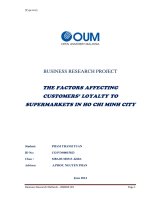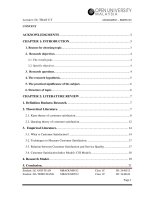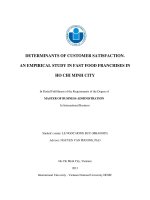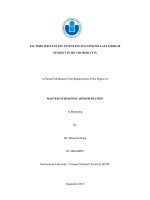Key organizational factors contribuiting to employee satisfaction an examination of small medium sized enterprisse in ho chi minh city
Bạn đang xem bản rút gọn của tài liệu. Xem và tải ngay bản đầy đủ của tài liệu tại đây (1.03 MB, 72 trang )
UNIVERSITY OF ECONOMICS HO CHI MINH CITY
International School of Business
**************************
Vo Thi Ngoc Linh
KEY ORGANIZATIONAL FACTORS
CONTRIBUTING TO EMPLOYEE SATISFACTION:
An examination of small-medium sized enterprises
in Ho Chi Minh City
MASTER OF BUSINESS (Honours)
Ho Chi Minh City – Year 2014
UNIVERSITY OF ECONOMICS HO CHI MINH CITY
International School of Business
**************************
VoThi Ngoc Linh
KEY ORGANIZATIONAL FACTORS
CONTRIBUTING TO EMPLOYEE SATISFACTION:
An examination of small-medium sized enterprises
in Ho Chi Minh City
ID: 22110084
MASTER OF BUSINESS (Honours)
SUPERVISOR: Dr. NGUYEN DANG LAM
Ho Chi Minh City – Year 2014
ii
ACKNOWLEDGEMENT
Firstly, I would like to express my sincerest gratitude to my supervisor, Dr. Nguyen Dang
Lam. who has supported my thesis with enthusiasm in guidance as well as instruction
knowledge in detail.
I would like to express appreciations to my ISB’s classmates, colleagues, friends, and
relatives. They helped me so much for finishing data survey, communicating usefully
information for my study.
Last but not least, I would like to thank my small family who gave me the best conditions to
carry out the thesis.
Sincerely
Vo Thi Ngoc Linh
April 2014.
i
ABSTRACT
One of the factors to bring advance competitiveness for enterprises in Vietnam is productive
labor. There are some forces helping to increase productivity from different activities as
training, physical support or morale. The best choice for increasing productivity and
enthusiasm in job is to create high satisfaction of employee with organization. Small Medium
Enterprises (SMEs) in Vietnam need to have more attention this aspect for competition with
rivals in Vietnam’s market as well as expending to international markets.
The purpose of this study, therefore, tries to examine key organizational characteristics
contributing to employee satisfaction in Vietnam’s SMEs. In detail, it surveys seven
organizational factors that influence employee satisfaction in enterprises. It includes factors
as purpose, structure, relationships, rewards, helpful mechanism, leadership, and attitude
toward change. The results form data survey of SMEs in Ho Chi Minh City and using data
analysis methods may support finding out key organizational factors impacting on employee
satisfaction. This thing can support enterprises to identify and apply the best strategies to
improve and develop labor productivity.
ii
TABLE OF CONTENTS
ACKNOWLEDGEMENT ..................................................................................... i
ABSTRACT ..........................................................................................................ii
TABLE OF CONTENTS .................................................................................... iii
LIST OF TABLES ..............................................................................................vii
LIST OF ABBREVIATIONS ........................................................................... viii
CHAPTER 1. INTRODUCTION ......................................................................... 1
1.1 Research background ................................................................................................... 1
1.2 Research objectives and questions ............................................................................... 2
1.3 Research contribution ................................................................................................... 3
1.4 Research scope ............................................................................................................... 4
1.5 Overview of research .................................................................................................... 4
CHAPTER 2. LITERATURE REVIEW .............................................................. 5
2.1 Definition of small-medium sized enterprise in Vietnam .......................................... 5
2.2 Employee Job satisfaction ............................................................................................ 6
2.3 Key organizational factors contributing to employee satisfaction ........................... 8
2.3.1 Purposes .................................................................................................................. 9
2.3.2 Structure ................................................................................................................. 9
2.3.3 Leadership ............................................................................................................ 10
2.3.4 Relationships ........................................................................................................ 10
2.3.5 Rewards ................................................................................................................ 10
2.3.6 Helpful mechanisms ............................................................................................. 11
2.3.7 Attitude toward change ....................................................................................... 11
2.4 Research model............................................................................................................ 12
2.5 Conclusion .................................................................................................................... 15
CHAPTER 3. RESEARCH METHODOLOGY ................................................ 16
3.1 Research process: ........................................................................................................ 16
iii
3.2 Measurement scale ...................................................................................................... 18
3.3 Sampling design ........................................................................................................... 22
3.4 Data collection method ............................................................................................... 22
3.5 Data analysis technical ................................................................................................ 22
3.5.1 Reliability analysis of measurement scales with Cronbach’s alpha ................ 23
3.5.2 Exploratory factor analysis ................................................................................. 23
3.5.3 Multiple regression analysis to test the impact of independent variables to
dependent variable ............................................................................................ 24
CHAPTER 4. DATA ANALYSIS and RESULTS ............................................ 26
4.1 Introduction ................................................................................................................. 26
4.2 Descriptive Analysis .................................................................................................... 26
4.2.1 Gender ................................................................................................................... 26
4.2.2 Age ......................................................................................................................... 26
4.2.3 The mean and standard deviation of independent and dependent variables. 27
4.3 Reliability analysis ...................................................................................................... 27
4.3.1 Reliability of Purpose .......................................................................................... 28
4.3.2 Reliability of Structure ........................................................................................ 28
4.3.3 Reliability of Leadership ..................................................................................... 29
4.3.4 Reliability of Relationship ................................................................................... 29
4.3.5 Reliability of Reward ........................................................................................... 30
4.3.6 Reliability of Helpful Mechanisms ..................................................................... 30
4.3.7 Reliability of Attitude toward Change ............................................................... 31
4.3.8 Reliability of Overall Satisfaction....................................................................... 31
4.4 Exploratory Factor Analysis (EFA) .......................................................................... 32
4.4.1 Assessing the scale measurement of independent variables ............................. 32
4.4.2 Assessing the scale measurement of dependent variable ................................. 35
4.5 Correlation Analysis ................................................................................................... 36
4.6 Multi-Linear Regression Analysis for testing hypotheses ....................................... 37
iv
4.7 Hypotheses testing ....................................................................................................... 38
CHAPTER 5. RECOMMENDATION AND CONCLUSION .......................... 42
5.1 Introduction ................................................................................................................. 42
5.2 Summary of the study results..................................................................................... 42
5.3 Managerial Implications ............................................................................................. 43
5.4 Conclusion and future research recommendation ................................................... 45
References ........................................................................................................... 46
APPENDICES .................................................................................................... 49
v
LIST OF FIGURES
Figure 1- Weisbord’s (1976) Organizational Diagnosis Model. ........................ 12
Figure 2- Research Model: Adapted from Weisbord’s (1976) and Preziosi’s
(1980) Organizational Diagnosis Model............................................................. 13
Figure 3- The proposal research method ............................................................ 15
vi
LIST OF TABLES
Table 1- SMEs Definition according to Decree 56/2009/ND-CP. ....................... 6
Table 2- Measurement scale of factors contributing to employee satisfaction .. 18
Table 3- Gender .................................................................................................. 26
Table 4- Age........................................................................................................ 27
Table 5- Descriptive Statistics of Variables ....................................................... 27
Table 6- Cronbach’s alpha of Purpose ................................................................ 28
Table 7- Cronbach’s alpha of Structure .............................................................. 28
Table 8- Cronbach’s alpha of Leadership ........................................................... 29
Table 9- Cronbach’s alpha of Relationship ........................................................ 29
Table 10- Cronbach’s alpha of Reward .............................................................. 30
Table 11- Cronbach’s alpha of Helpful Mechanisms ......................................... 30
Table 12- Cronbach’s alpha of Attitude toward Change .................................... 31
Table 13- Cronbach’s alpha of Employee Overall Satisfaction ......................... 31
Table 15- Rotated Component Matrix ................................................................ 34
Table 16- KMO and Bartlett's Test of dependent variable ................................. 35
Table 17- Total Variance Explained of dependent variable ............................... 35
Table 18- Component Matrix of dependent variable .......................................... 36
Table 19- Correlations ........................................................................................ 36
Table 20- Model Summary ................................................................................. 38
Table 21- Anova Result ...................................................................................... 38
Table 22- Coefficients Result ............................................................................. 39
Table 23- Research results .................................................................................. 41
vii
LIST OF ABBREVIATIONS
SMEs:
Small-medium Enterprises
EFA:
Exploratory Factor Analysis
KMO:
Kaiser-Meyer-Olkin
PUR:
Purpose
STR:
Structure
LEA:
Leadership
REL:
Relationships
REW:
Rewards
HEL:
Helpful Mechanisms
CHA:
Attitude toward Change
viii
CHAPTER 1. INTRODUCTION
1.1 Research background
Along with the fast development of science and technology, human resource is becoming a
leading competitive factor in business organizations. Businesses focus on increasing their
employee satisfaction because satisfied employees will become more enthusiastic, fervent in
job and loyal to company’s goals. Thus, identifying factors that can impact on employee
satisfaction is of the utmost importance to today’s managers.
When employees satisfy with their job and organization, they are easy to accept change
conditions and are quite willing to contribute to organizational initiatives to bring profits for
enterprise. In addition, labor cost can be decreased. The costs of recruiting and training are
significantly reduced because employees are willing to stay with job. For example, in HP
Corporation, managers have allowed employees to arrange their working hours. With flexible
time work plan, workers have had reasonable period of time for job and enjoyed the holidays
with relatives. This helped HP reduce 36% overtime cost and costs of recruiting and training
were also noticeably decreased (Weekly Saigon Entrepreneur, 2013).
According to VTV News, SMEs in Vietnam face many challenges in international
competition since Vietnam opened its economy to the world. SMEs are lack of strategic
competitiveness because of poor management and labor capacity, small scale, limited capital,
and backward technology that forces price to increase while making product quality
decreasing (Da Thao, 2013; PhanThanh Hai, 2013). Facing tough competition from both
domestic and international competitors, SMEs in Vietnam need to redefine their resources,
capabilities, and core competences and have strategic plans to be able to win the market.
Furthermore, as SMEs contribute greatly to the economy, it is strategically crucial to develop
this sector to achieve the country’s sustainable growth.
1
Among the top strategic directions to help SMEs gain competitive advantage and achieve
strategic competitiveness, building a high performance work system that produces superior
employee performance is perhaps the most important initiative. One of the ways to
accomplish this mission is to increase employee satisfaction and their commitment to the
organization.
In previous research, many authors studied the impact of organizational characteristics on
employee satisfaction. Because most people spend almost a lifetime for work, understanding
of the factors that help increase satisfaction is important to improve the well-being of
individuals (Grunneberg, 1997). Recent research results have shown that the level of
satisfaction of employees in local companies in Vietnam was low (Duong &Swierczek, 2008;
Yu & Lyons, 2012).
This research, therefore, focuses on understanding key organizational factors contributing to
employee satisfaction in SMEs. It helps confirm necessary factors that enterprises need to
focus on in order to improve their employee satisfaction. Generally, understanding employee
satisfaction help SMEs gain some important advantages such as maintaining employee
commitment, increasing employee performance, and increasing competitive advantage. It
also attempts to examine some key organizational factors that have studied in western
cultures and see if they can apply on SMEs in Vietnam.
1.2 Research objectives and questions
To become an industrialized country, Vietnam has faced the challenge of deficiency in
qualified work force (Truong et al., 2010). According to a Gallup survey conducted in 2011,
Vietnamese employees were least happy among Asian workers (Yu & Lyon, 2012).
Research on job satisfaction has paid quite a lot of attention to organizational factors
(Lorianne, 2011; Yiicel, 2012). Job satisfaction relates to various organizational
2
characteristics and behaviors in the workplace (Boles et al., 2007; Ejere, 2010; Kantabura &
Avery, 2007; Nguyen, 2011; Valentine et al., 2011).
The objective of this study is to determine key organizational factors impact on employee
satisfaction. It includes three main contents as follow:
- To examine level of employee satisfactionin SMEs in Ho Chi Minh City.
- To identify the key organizational factors contributing to employee satisfactionin SMEs in
Ho Chi Minh City.
- To find out the strength of each factor on level of employee satisfaction in SMEs in Ho
Chi Minh City.
In this study, seven organizational characteristics of SMEs in Ho Chi Minh City including
purposes, structure, relationships, rewards, helpful mechanism, leadership, and attitude
toward change is tested. The study reports influence of these seven factors on employee
satisfaction. For the purpose of the research, research questions to survey key organizational
factors contributing employee satisfaction are as follows:
- Is there a relationship between each of the seven factors of organizational characteristics
and employee satisfaction?
- How strong is the relationship between each of the seven factors of organizational
characteristics and employee satisfaction?
1.3 Research contribution
As stated earlier in this study, the level of employee satisfaction in local companies in
Vietnam was low (Duong & Swierczek, 2008; Yu & Lyons, 2012). This may be because of
the lack of skilled workers at these companies (Henderson & Tullock, 2008). In reality, there
are many different reasons and factors contributing to employee satisfaction. At the
theoretical level, this research contributes to previous studies in the literature of
organizational study by shedding more light in understanding how organizational
3
characteristics can impact on employee satisfaction. At the practical level, this research can
help managers of SMEs in Ho Chi Minh City have an overview on key organizational factors
that impact on employee overall satisfaction. It also helps them recognize how each key
factor can strengthen the level of employee satisfaction. The research has implications for not
only Vietnamese managers but also for organization development practitioners, as to how to
increase the employee satisfaction in SMEs in Ho Chi Minh City.
1.4 Research scope
This study is limited to the investigation of SMEs in Ho Chi Minh City only. It focuses on a
few referential enterprises in Ho Chi Minh City. Thus, it is not necessarily representative
other enterprises from different areas in Vietnam. The population of this study is staff and
supervisor level.
1.5 Overview of research
This research includes five chapters that indicate the context as follows:
Chapter 1: Introduce the background of the research, research objective and questions,
as well as research contribution and scope.
Chapter 2: Indicate literature review context that concerned factors belong to
organizational characteristics, and employee satisfaction.
Chapter 3: Indicate contents concerning research methodology, such as research
design, sampling design and data collection.
Chapter 4: Indicate data analysis, hypotheses testing and report result of the research.
Chapter 5: Conclusion of the research as well as recommendation.
4
CHAPTER 2. LITERATURE REVIEW
Purpose of this chapter is to review concepts of employee satisfaction and organizational
characteristics (purposes, structure, relationships, rewards, helpful mechanism, leadership,
and attitude toward change). It focuses on previous research concerning the seven factors of
organizational characteristics, employee satisfaction and the impact of organizational
characteristics to employee satisfaction.
2.1 Definition of small-medium sized enterprise in Vietnam
Based on regulations of Vietnam government, a small-medium sized enterprise is a business
that it registered in accordance with law statements. SMEs are regularly divided into three
groups of micro, small and medium enterprise’s size according to size of total fund or the
average labor. Besides sizes, they can be categorized by locations, technological development
or types of organization. Table 1 below presents the classification of Vietnamese SMEs
(Nguyen, H.L. 2011).
5
Table 1- SMEs Definition according to Decree 56/2009/ND-CP.
Size
Micro
Small enterprise
enterprise
Field
I. Agriculture,
forestry and
Less than 10
fisheries
II. Industry and
construction
III. Trade and
services
Capital
Employees
Less than 10
Less than 10
(VND)
Employees
Less than 20
From 10 to
million
200
Less than 20
From 10 to
million
200
Less than 10
From 10 to
million
50
Medium enterprise
Capital
(VND)
From 20
million to
100 billion
From 20
million to
100 billion
From 20
million to 50
billion
Employees
From 200
to 300
From 200
to 300
From 50 to
100
According to assessment of Cao Si Kiem, he is The President of Business Association of
SMEs in Vietnam. SMEs has capital less than one million VND take a rate of 40 percent;
capital from one to five million VND take a rate of 37 percent; from five to ten million VND
take a rate of 8 percent and remaining are more than 10 million VND (Pham Thanh Hai,
2013). With small capital, most SMEs have loans from various sources. This is one of reason
making severe competition for SMEs.
2.2 Employee Job satisfaction
There are many definitions of employee satisfaction in organizational behavior study. Cranny
et al. (1992) defined employee satisfaction as “an employee’s affective reactions to a job
based on comparing actual outcomes with desired outcomes.” According to Hodson (1991),
employee satisfaction is a broad concept, relating to an individual’s attitude towards his job
or several aspects of the jobs. Ellickson and Logsdon (2002) defined employee satisfaction as
“the extent employees like their work.” Jyoti and Sharma (2012) defined employee
6
satisfaction as “the extent to which the employees of a firm feel that their interests are being
looked after by the management.” Spector (1997) claimed that employee satisfaction simply
was when people felt like their job and other aspects of work. When employees satisfy with
job, they will focus more attention into working and easy have commitment toward
organization’s target. Employee satisfaction is often considered as an important outcome of
organizational activity and is used to measure attitude and motivation (James & Jones, 1976;
Meadow, 1980).
According to Naseem et al. (2011), employee satisfaction is a complex, multi-faceted
construct which can be impacted by many factors such as wages, work environment,
supervisors and co-worker relationships (Lane at al., 2010). Parvin and Kabir (2011)
indicated a link between how employees regard their jobs and their resulting feelings. When
supervisors show support, it can positively influence employee satisfaction.
Many researchers theorize that the employee satisfaction leads to commitment to the
organizations (DeCotiis & Summers, 1987; Mathieu, 1988; Mathieu & Hamel, 1989). Luddy
(2005) defined employee satisfaction as the emotional reaction and feelings towards different
aspects at work of the staff. The author emphasized the causes of employee satisfaction
including job title, level of supervision, relationships with colleagues, job content,
compensation, and rewards consisting of promotion, physical conditions of working
environment, as well as the structure of the organization.
Employee satisfaction and productivity are the two criteria of organizational effectiveness
(Meltzer & Salter, 1962). Employee satisfaction is an important outcome of organizational
activity and is among the measures of attitude and motivation that are related to
organizational study (James & Jones, 1976; Meadow, 1980).
In general, when people satisfied with their work, they tend to have positive feeling and
attitude related to their jobs. This helps increase employee performance. Sometimes
7
employees think that the present job may be better than other jobs because they love their job.
Furthermore, in order to retain their existing satisfied jobs, employees try to perform work
more effectively. This helps to increase benefit for the enterprise. Therefore, to increase
working effect, enterprises should try to enhance employee satisfaction inside their
organization (Karim & Rehman, 2012).
Base on the review of the literature of job satisfaction as well as its influence on the company
bottom line, this research studies impact of organizational characteristics to employee
satisfaction. There are total of
seven factors will be examined characteristics of an
organization including purposes, structure, relationships, rewards, helpful mechanism,
leadership, and attitude toward change. By the result of survey will show different impact of
every factor to employee satisfaction.
2.3 Key organizational factors contributing to employee satisfaction
Ostroff and Schmitt (1993) believed that the effectiveness of an organization depends on
many factors such as work culture, employee satisfaction, and many other organizational
components. There have been many studies examining the relationship between
organizational characteristics and employee satisfaction (Nguyen, 2011). For example, Blum
et al. (1995) found that employees who worked in bureaucratic organizations had lower
satisfaction than those who worked in other types of organizations. They also found that
decentralized organizations might benefit both employee satisfaction and organizational.
Ghiselli & Johnson (1970) believed that the structural shape (tall or flat) of the organizations
had an impact on the relationship between managerial need satisfaction and organizational
success. Luddy (2005) emphasized the causes of employee satisfaction including job title,
level of supervision, relationships with colleagues, job content, compensation, and rewards
consisting of promotion, physical conditions of the working environment, as well as the
structure of the organization.
8
2.3.1 Purposes
According to Moynihan and Pandey (2006), purpose is defined as a sort of psychological
negotiation between “what we have to do” (for survival) and “what we want to do” (for
growth, self-expression, idealism, and so on). Goal should meet the two requirements: clarity
and agreement. Goal clarity indicates how well articulated the goals in the formal system are
and to what extent the organization members are clear about the organization’s purposes and
mission. Goal agreement illustrates the extent to which people understand and support the
organization’s purposes (Preziosi, 1980). When employee can understand organization goals,
they will associate with organization more easily. So purpose influences level of employee
satisfaction, this study developed the following hypothesis:
H1: There is a positive impact of organizational purpose on employee satisfaction.
2.3.2 Structure
Drucker (1998) concludes that there are two universal principles of organization. First, the
organization needs to be transparent so that people can understand clearly how their work is
structured and what expect from them. Second, the organization needs to be as flat as
possible. The more layers there are, the more opportunity for miscommunication and poor
management.
According to James and Jones (1976), they define organizational structure as the enduring
characteristics of an organization reflected by the distribution of units and positions within
the organization and their systematic relationships to each other. Priziosi (1980) defines
organizational structure as the division of labor and as the manner in which work tasks are
divided. From this statement, this study developed the following hypothesis:
H2: There is positive impact of organization structure on employee satisfaction.
9
2.3.3 Leadership
Leadership plays important role in influence employee satisfaction. From the Hawthorn
experiment and the behavior research that followed, focused and placed on dynamic leaders
and the meaning, nature and origins of leadership. Liker suggested that leadership people was
the central and the most significant aspect of all the tasks of management that encouraged a
sense of participative or consultative management (James Carlopio & Graham Andrewartha,
2008).
According to Priziosi (1980), the definition of leadership includes both immediate
supervisors and organizational leaders. It involves in the leadership norms. Leadership
requires an understanding of the environment in addition to behavior skills. The leaders
should not know and do everything, but they should know where the trouble spots are and
how these affect the whole organization. Leaders should systematically monitor and initiate
efforts to help. Besides, leadership has affects on employees. In that way, this study
developed the following hypothesis:
H3: There is a positive impact of leadership on employee satisfaction.
2.3.4 Relationships
Priziosi (1980) defines relationships as the interdependence between people-peers or bosssubordinate, between units doing different tasks, and between people and their technologies.
Quality of the relationship impacts organization’s performance and effectiveness.
Relationships also indicate the capability of managing conflict in an organization. With that
in mind, this study developed the following hypothesis:
H4: There is a positive impact of organization relationship on employee satisfaction.
2.3.5 Rewards
Knowledge of need theory helps managers to understand whether organizational rewards are
significant reinforces for special individuals. If a reward satisfies an activated personal need,
10
it can use to reinforce desired individual behaviors. The difficulty many managers have in
predicting what rewards will be most attractive to their employees (James Carlopio &
Graham Andrewartha, 2008).
Priziosi (1980) defines rewards as opportunity to grow as a person, the pay scale and benefits,
the opportunity for promotion, salary, and incentives associated with tasks. A good reward
system is the one that not only pays off in fringe benefits and salary but also shows people the
value of their work. It should guarantee the equity and fairness among employees. Based on
this literature, this study developed the following hypothesis:
H5: There is a positive impact of organizational rewards on employee satisfaction.
2.3.6 Helpful mechanisms
Helpful mechanisms are defined as the procedures, policies, meetings, systems, committees,
office facility, information, work units, planning and control systems, and so on, that
facilitate the organizational efforts (Priziosi,1980). They are coordinating factors that bind the
organization together to make it more than a sum of individuals with separate needs. Thus,
this study developed the following hypothesis:
H6: There is a positive impact of organization helpful mechanisms on employee
satisfaction.
2.3.7 Attitude toward change
Change in today’s information is a constant and will increase. Access to more information in
increasing amounts leads to increased turbulence and complexity for managers. Attitude
toward change is an individual psychological tendency that is expressed by recognizing,
evaluating the change and behavior toward it with some degree of favor or disfavor (Eagly &
Chaiken, 1998; Elizur & Guttman, 1976). It indicates how changeable the organization is. It
is the ability to change of the organization (Preziosi, 1980). It includes both organization and
11
individual attitude toward change. With above literature, this study developed the following
hypothesis:
H7: There is a positive impact of attitude toward change on employee satisfaction.
2.4 Research model
This study uses Preziosi’s (1980) Organizational Diagnosis Questionnaire (ODQ), an
extension Six-Box Organizational Model of Weisbord’s (1976). It used the same items
appearing in Weisbord model, together an additional factor “attitude to change”. Weisbord’s
model establishes a systematic approach for analyzing relationship among variables that
influence how an organization is managed.
Purposes:
What business are
we in?
Relationships:
How do we
manage conflict
among peope?
With
technologies?
Leadership:D
oes someone
keep the boxes
in balance?
Helpful Mechanisms:
Have we adequate
coordinating
technologies?
Structure:
How do we
divide up the
work?
Rewards:
Do all needed
tasks have
incentives?
Environment
Figure 1- Weisbord’s (1976) Organizational Diagnosis Model.
This model provides for assessment in six areas of organizational activity: purpose, structure,
relationship, rewards, leadership and helpful mechanisms. The outer circle determines an
organizational boundary that it clarifies the functioning of the internal environment is to be
12
analyzed to the exclusion of the external environment.
Preziosi argues that in attempting any planned change effort in an organization, it is
necessary to know how changeable an organization is (Lok& Crawford, 2000). Putting
together the additional component suggested by Preziosi’s (1980), the author studied
organizational components that impact to employee satisfaction. It has seven key
organizational factors including purposes, structure, leadership, relationships rewards, helpful
mechanisms, and attitude toward change as figure 2 follows.
Helpful Mechanisms
Relationships
Structure
Organizational
Effectiveness
Leadership
Purposes
Reward
s
Overall Job
Satisfaction
Attitude toward Change
Organizational
Characteristic
s
External
Environment
Figure 2- Research Model: Adapted from Weisbord’s (1976) and Preziosi’s
(1980)Organizational Diagnosis Model.
13
Robert C. Preziosi assumed that a meaningful diagnostic effort must be based on a theory or
model of organizational functioning. This makes action research possible as it facilitates
problem identification, which is essential to organization development.
This study examines the influence of organizational components to employee satisfaction in
SMEs. It surveys seven key organizational factors including purposes, structure, leadership,
relationships rewards, helpful mechanisms, and attitude toward change. Beside of key
organizational factors, the study is also survey demographic factor. It helps to examine the
difference in level of employee satisfaction based on age, gender and experience of
employees. The research hypotheses for this study, therefore, are as follows:
Hypothesis 1: Purposes have a positive impact on employee overall satisfaction.
Hypothesis 2: Structure has a positive impact on employee overall satisfaction.
Hypothesis3: Leadership has a positive impact on employee overall satisfaction.
Hypothesis 4: Relationships have a positive impact on employee overall satisfaction.
Hypothesis 5: Rewards have a positive impact on employee overall satisfaction.
Hypothesis 6: Helpful mechanisms have a positive impact on employee overall
satisfaction.
Hypothesis 7: Attitude toward change has a positive impact on employee overall
satisfaction.
14
Figure 3- The proposal research method
H1
Purpose
Structure
Leadership
Relationships
H2
H3
H4
Employee Overall
Satisfaction
H5
Rewards
Helpful
Mechanisms
H6
H7
Attitude toward
Change
The research model is presented in the figure 3 and consisted of the 7 hypotheses listed
above. Seven key organizational factors from hypothesis 1 to hypothesis 7 are independent
and quantitative variables. Employee satisfaction is the dependent variable. All of them have
positive impact on dependent variable, employee satisfaction.
2.5 Conclusion
There were so many researches on employee satisfaction, organizational characteristics from
different factors as well as other organizations. This chapter indicates more detail relationship
between seven variables of organizational characteristics and employee satisfaction.
Literature is presented possible relationship of variables that help study more clearly.
15


